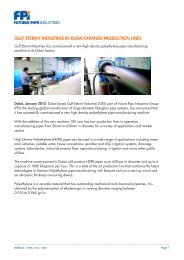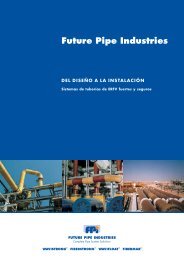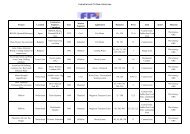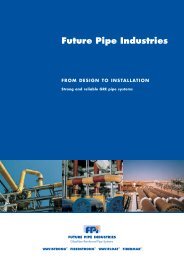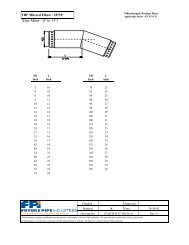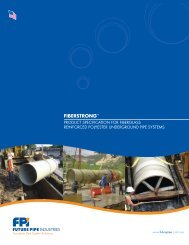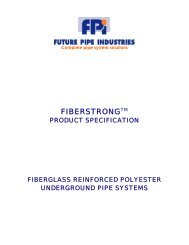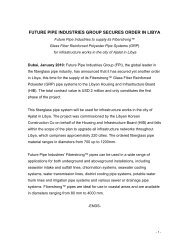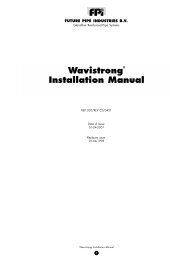Untitled - Future Pipe Industries
Untitled - Future Pipe Industries
Untitled - Future Pipe Industries
Create successful ePaper yourself
Turn your PDF publications into a flip-book with our unique Google optimized e-Paper software.
7.4 Volume of water required<br />
Table 13 indicates the approximate volume of water required in order to fill pipes per 100 feet of pipeline.<br />
DN<br />
Inch<br />
Water volume (gal)<br />
/ 100 ft of pipeline<br />
3 39<br />
4 69<br />
6 154<br />
8 270<br />
10 430<br />
12 615<br />
14 840<br />
16 1,100<br />
18 1,390<br />
20 1,700<br />
24 2,450<br />
28 3,350<br />
30 3,850<br />
33 4,700<br />
34 4,950<br />
Table 13<br />
7.5: Initial test (method 1)<br />
After the test section is ready, the line shall be filled with water and kept under low pressure (30 psig) for at least 12 hours<br />
to allow the pipeline to stabilize and to release the entrapped air from the line. After the stabilization period, the pressure<br />
shall be raised gradually at a rate of 15 – 30 psi every half an hour, until the intended test pressure at the lowest point is<br />
reached.<br />
Unless otherwise specified by the Engineer, the test pressure shall be equal to 1.5 times the intended working pressure of the<br />
pipeline section. Once the required test pressure is reached, the pressure should be maintained for one hour, by pumping if<br />
necessary. The pump should then be disconnected and no further water permitted to enter the pipeline section for one hour.<br />
At the end of this one-hour period, the original test pressure shall be restored by pumping water from a graduated water tank<br />
and measuring the amount of water necessary to restore the test pressure. Unless otherwise specified by the Engineer, the test<br />
water loss should not exceed .03 US gallons / inch of diameter per mile of pipeline per 24 hours per psig of test pressure<br />
applied (average test pressure of section). This is equivalent to 4.5 gpd / mile / inch for a 150 psig test pressure.<br />
During the pressure test, all joints should be visually inspected (where possible), and all visual leaks should be repaired. In<br />
case the test in not satisfactory, the locations of the leaks shall be determined and rectified, and the line re-tested in the same<br />
manner as shown above. The test section shall be accepted only after successfully passing the above leakage test.<br />
Note: The Contractor should note that while pressure testing large diameter pipe on site at pressures generally above 150<br />
psi, there is a possibility of a slight rotation/pivoting of the Reka coupling. This is the result of uneven pressure against the<br />
various parts of the coupling, and is inevitable during normal joint assembly where a perfectly centered and aligned joint<br />
can never be achieved. In the unlikely event that one or more joint starts to rotate or to shift slightly during the pressure test,<br />
it is advisable to reduce the pressure, and to backfill the joints completely using selected, properly compacted backfill, prior<br />
to resumption of the pressure test. Any joint that has shifted significantly should be centered again before resuming the pressure<br />
test.<br />
38<br />
DN<br />
Inch<br />
Water volume (gal)<br />
/ 100 ft of pipeline<br />
36 5,550<br />
42 7,500<br />
48 9,900<br />
54 12,500<br />
60 15,400<br />
72 22,200<br />
80 27,500<br />
96 39,500<br />
108 49,950<br />
114 55,650<br />
120 61,700<br />
132 74,500<br />
144 88,800<br />
158 107,000



